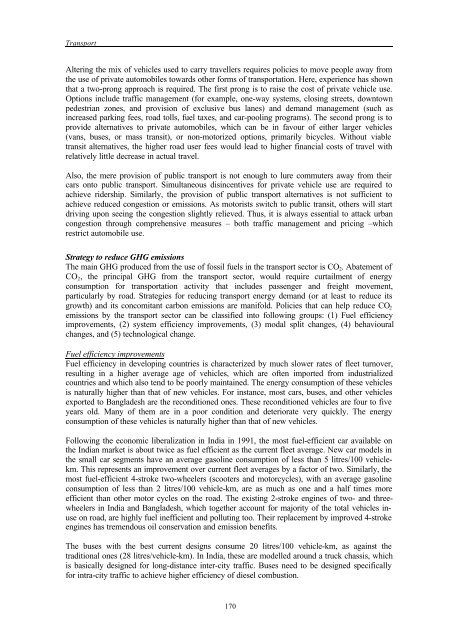sectoral economic costs and benefits of ghg mitigation - IPCC
sectoral economic costs and benefits of ghg mitigation - IPCC
sectoral economic costs and benefits of ghg mitigation - IPCC
Create successful ePaper yourself
Turn your PDF publications into a flip-book with our unique Google optimized e-Paper software.
Transport<br />
Altering the mix <strong>of</strong> vehicles used to carry travellers requires policies to move people away from<br />
the use <strong>of</strong> private automobiles towards other forms <strong>of</strong> transportation. Here, experience has shown<br />
that a two-prong approach is required. The first prong is to raise the cost <strong>of</strong> private vehicle use.<br />
Options include traffic management (for example, one-way systems, closing streets, downtown<br />
pedestrian zones, <strong>and</strong> provision <strong>of</strong> exclusive bus lanes) <strong>and</strong> dem<strong>and</strong> management (such as<br />
increased parking fees, road tolls, fuel taxes, <strong>and</strong> car-pooling programs). The second prong is to<br />
provide alternatives to private automobiles, which can be in favour <strong>of</strong> either larger vehicles<br />
(vans, buses, or mass transit), or non-motorized options, primarily bicycles. Without viable<br />
transit alternatives, the higher road user fees would lead to higher financial <strong>costs</strong> <strong>of</strong> travel with<br />
relatively little decrease in actual travel.<br />
Also, the mere provision <strong>of</strong> public transport is not enough to lure commuters away from their<br />
cars onto public transport. Simultaneous disincentives for private vehicle use are required to<br />
achieve ridership. Similarly, the provision <strong>of</strong> public transport alternatives is not sufficient to<br />
achieve reduced congestion or emissions. As motorists switch to public transit, others will start<br />
driving upon seeing the congestion slightly relieved. Thus, it is always essential to attack urban<br />
congestion through comprehensive measures – both traffic management <strong>and</strong> pricing –which<br />
restrict automobile use.<br />
Strategy to reduce GHG emissions<br />
The main GHG produced from the use <strong>of</strong> fossil fuels in the transport sector is CO 2 . Abatement <strong>of</strong><br />
CO 2 , the principal GHG from the transport sector, would require curtailment <strong>of</strong> energy<br />
consumption for transportation activity that includes passenger <strong>and</strong> freight movement,<br />
particularly by road. Strategies for reducing transport energy dem<strong>and</strong> (or at least to reduce its<br />
growth) <strong>and</strong> its concomitant carbon emissions are manifold. Policies that can help reduce CO 2<br />
emissions by the transport sector can be classified into following groups: (1) Fuel efficiency<br />
improvements, (2) system efficiency improvements, (3) modal split changes, (4) behavioural<br />
changes, <strong>and</strong> (5) technological change.<br />
Fuel efficiency improvements<br />
Fuel efficiency in developing countries is characterized by much slower rates <strong>of</strong> fleet turnover,<br />
resulting in a higher average age <strong>of</strong> vehicles, which are <strong>of</strong>ten imported from industrialized<br />
countries <strong>and</strong> which also tend to be poorly maintained. The energy consumption <strong>of</strong> these vehicles<br />
is naturally higher than that <strong>of</strong> new vehicles. For instance, most cars, buses, <strong>and</strong> other vehicles<br />
exported to Bangladesh are the reconditioned ones. These reconditioned vehicles are four to five<br />
years old. Many <strong>of</strong> them are in a poor condition <strong>and</strong> deteriorate very quickly. The energy<br />
consumption <strong>of</strong> these vehicles is naturally higher than that <strong>of</strong> new vehicles.<br />
Following the <strong>economic</strong> liberalization in India in 1991, the most fuel-efficient car available on<br />
the Indian market is about twice as fuel efficient as the current fleet average. New car models in<br />
the small car segments have an average gasoline consumption <strong>of</strong> less than 5 litres/100 vehiclekm.<br />
This represents an improvement over current fleet averages by a factor <strong>of</strong> two. Similarly, the<br />
most fuel-efficient 4-stroke two-wheelers (scooters <strong>and</strong> motorcycles), with an average gasoline<br />
consumption <strong>of</strong> less than 2 litres/100 vehicle-km, are as much as one <strong>and</strong> a half times more<br />
efficient than other motor cycles on the road. The existing 2-stroke engines <strong>of</strong> two- <strong>and</strong> threewheelers<br />
in India <strong>and</strong> Bangladesh, which together account for majority <strong>of</strong> the total vehicles inuse<br />
on road, are highly fuel inefficient <strong>and</strong> polluting too. Their replacement by improved 4-stroke<br />
engines has tremendous oil conservation <strong>and</strong> emission <strong>benefits</strong>.<br />
The buses with the best current designs consume 20 litres/100 vehicle-km, as against the<br />
traditional ones (28 litres/vehicle-km). In India, these are modelled around a truck chassis, which<br />
is basically designed for long-distance inter-city traffic. Buses need to be designed specifically<br />
for intra-city traffic to achieve higher efficiency <strong>of</strong> diesel combustion.<br />
170
















